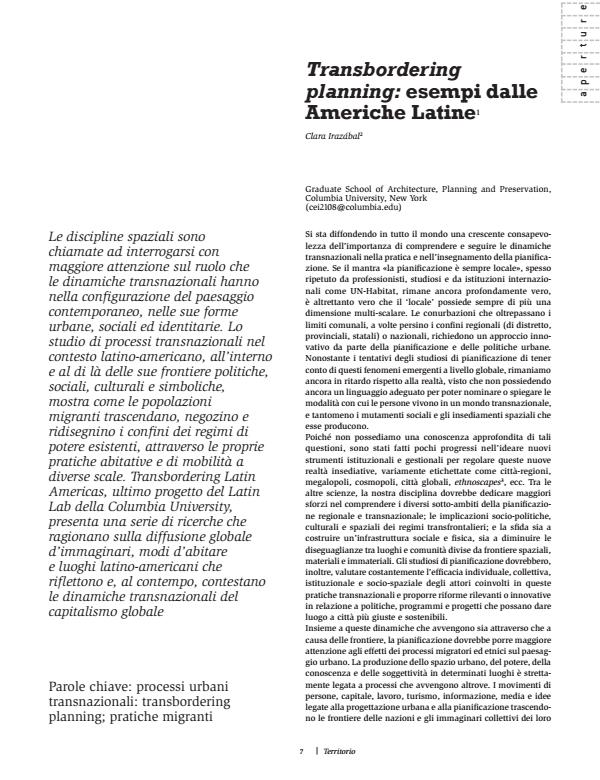Transbordering planning: esempi dalle Americhe Latine
Titolo Rivista TERRITORIO
Autori/Curatori Clara Irazàbal
Anno di pubblicazione 2014 Fascicolo 2014/69
Lingua Italiano Numero pagine 11 P. 7-17 Dimensione file 365 KB
DOI 10.3280/TR2014-069001
Il DOI è il codice a barre della proprietà intellettuale: per saperne di più
clicca qui
Qui sotto puoi vedere in anteprima la prima pagina di questo articolo.
Se questo articolo ti interessa, lo puoi acquistare (e scaricare in formato pdf) seguendo le facili indicazioni per acquistare il download credit. Acquista Download Credits per scaricare questo Articolo in formato PDF

FrancoAngeli è membro della Publishers International Linking Association, Inc (PILA)associazione indipendente e non profit per facilitare (attraverso i servizi tecnologici implementati da CrossRef.org) l’accesso degli studiosi ai contenuti digitali nelle pubblicazioni professionali e scientifiche
Le discipline spaziali sono chiamate ad interrogarsi con maggiore attenzione sul ruolo che le dinamiche transnazionali hanno nella configurazione del paesaggio contemporaneo, nelle sue forme urbane, sociali ed identitarie. Lo studio di processi transnazionali nel contesto latino-americano, all’interno e al di là delle sue frontiere politiche, sociali, culturali e simboliche, mostra come le popolazioni migranti trascendano, negozino e ridisegnino i confini dei regimi di potere esistenti, attraverso le proprie pratiche abitative e di mobilità a diverse scale. Transbordering Latin Americas, ultimo progetto del Latin Lab della Columbia University, presenta una serie di ricerche che ragionano sulla diffusione globale d’immaginari, modi d’abitare e luoghi latino-americani che riflettono e, al contempo, contestano le dinamiche transnazionali del capitalismo globale
Parole chiave:Processi urbani transnazionali: transbordering planning; pratiche migranti
- Border/scapes. Borderlands and design studies in dialogue Alice Buoli, in TERRITORIO 72/2015 pp.83
DOI: 10.3280/TR2015-072013 - Borderscaping: design patterns and practices on/across borderlands Alice Buoli, in TERRITORIO 72/2015 pp.85
DOI: 10.3280/TR2015-072014 - Forme dell'abitare transnazionale. Il caso di Vilcabamba, Ecuador Antonio Di Campli, in TERRITORIO 88/2019 pp.120
DOI: 10.3280/TR2019-088018 - New Methods for Studying Transnational Architecture and Urbanism: A Primer Davide Ponzini, Fabio Manfredini, in TERRITORIO 80/2017 pp.97
DOI: 10.3280/TR2017-080015
Clara Irazàbal, Transbordering planning: esempi dalle Americhe Latine in "TERRITORIO" 69/2014, pp 7-17, DOI: 10.3280/TR2014-069001